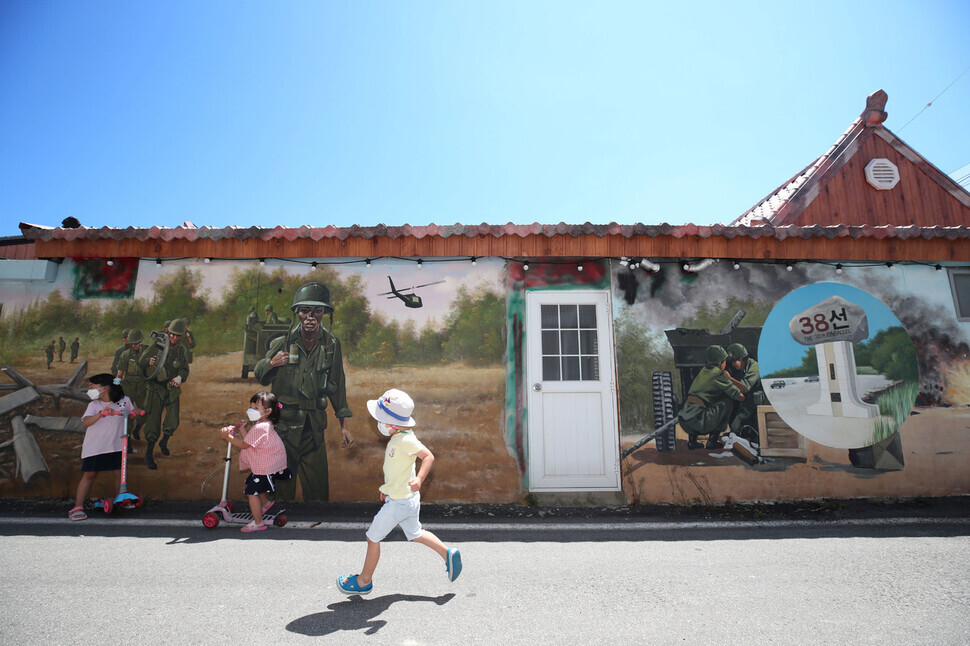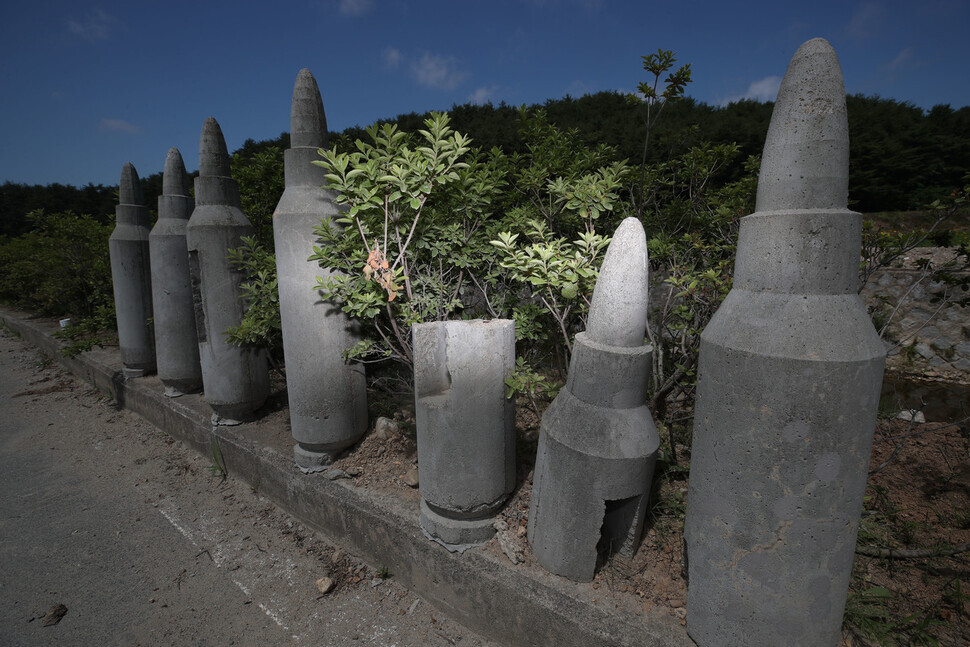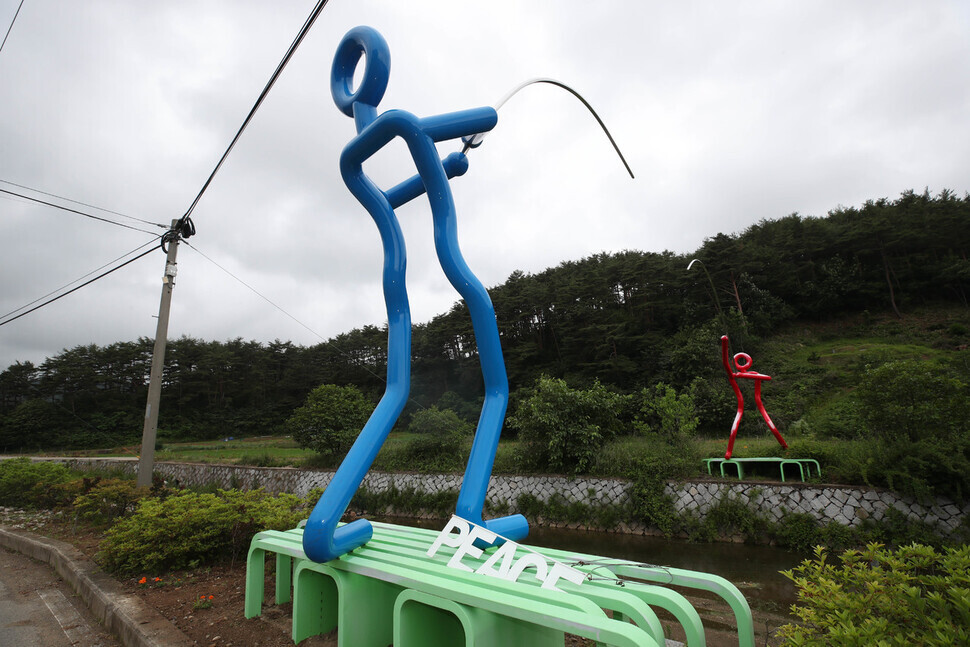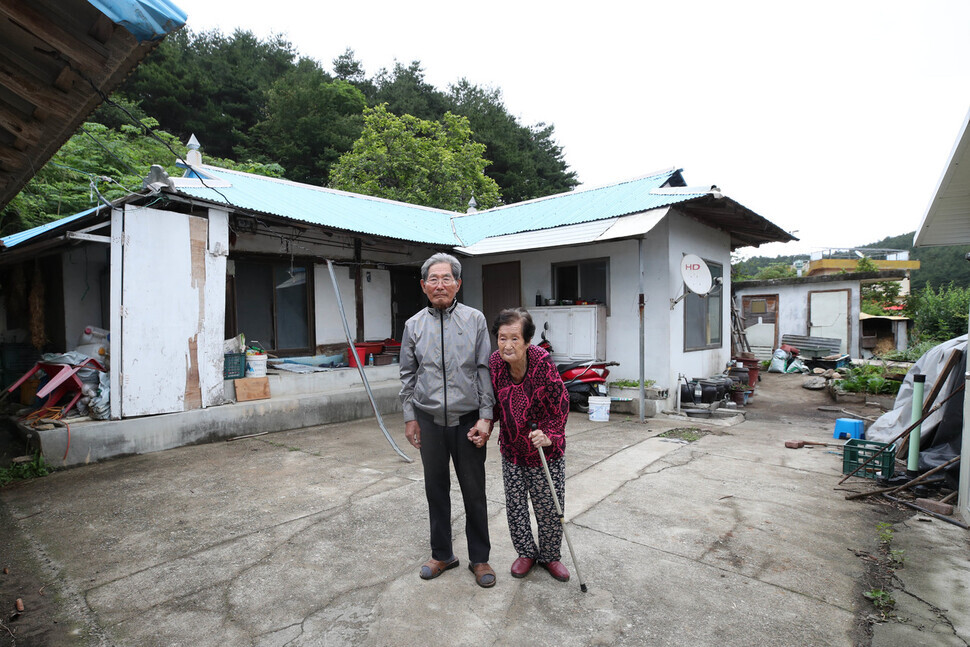hankyoreh
Links to other country sites 다른 나라 사이트 링크
[Photo essay] Peace thrives in village once split up by 38th Parallel

Heading north along National Highway 7 between Gangreung and Sokcho, travelers come across “38 Peace Village,” which still bears the scars of the Korean War.
As they arrive in the village across 38 Bridge in the Hyeonbuk township of Yangyang County, Gangwon Province, they are greeted by small stone sculptures shaped like artillery shells. Flowing across the village is Jangyo Stream (also known as “38th Parallel Stream,” where visitors can see “One Heart,” a sculpture of “fishing for peace,” and “Echoes of Survival, the Bell of Peace,” an artwork incorporating a metal bridge that was once suspended from a chestnut tree at the village hall’s entrance, where it served as a bell warning the village of dangers.

These artworks are part of the Jangyo Village Public Art Project, established in 2012 to raise awareness of the ravages of the Korean War and express a message for peace.
38 Peace Village was indeed a peaceful village once, with a ring of small mountain peaks surrounding it like a folding screen and keeping it safe from typhoons. But in 1945, it suffered the scarring experience of being divided in two by the 38th Parallel.
Hong Pil-nyeo, a 94-year-old who was born and grew up here, remembers it well.
“One day in 1945, the Russians [Soviet Army] and US soldiers came to Jangyo Village, put up a curtain on the 38th Parallel, and said, ‘This part is North Korea and this part is South Korea,’” she recalled.

“So Soon-hee’s room upstairs was part of the South, and the kitchen was part of the North. The neighborhood kids couldn’t even go to school because of that curtain.”
Hong’s home was split between South and North: the same exact land, but North Korea’s yesterday and South Korea’s today.
After the Korean War broke out, Hong and other villages fled and took refuge in the South.
“The day the war broke out, the sounds of shells rang out early in the morning, so I went up on the mountain and saw the [North Korean] People’s Army coming, waving their flags in the blackness of night,” she recalled in an oral history of Yangyang residents about their experiences during the war.

“My mother told us that my oldest sister was too frail to carry a baby on her back, so I should go take refuge with my sisters in Ingu. We followed the ROK Army to the 5th Company headquarters in Ingu, and the People’s Army followed behind us, firing their guns.”
When the war ended, she returned to find her home burnt to the ground.
“My father and husband rebuilt it. This house was where my parents both passed away and where I raised my three sons,” Hong said.
From Hong’s house, Jangyo Stream leads out to the sea, where surfers were enjoying the early summer waves on the jade-green East Sea. It felt like the scars of war had been borne along the stream’s waters to dissolve into the sea.

I looked back at the serenity of 38 Peace Village. On the corners leading back to the village, works of art stood quietly as though keeping the peace.
By Baek So-ah, staff photographer
Please direct comments or questions to [english@hani.co.kr]

Editorial・opinion
![[Column] Tariffs on China: Trump was dumb, Biden dumber [Column] Tariffs on China: Trump was dumb, Biden dumber](https://flexible.img.hani.co.kr/flexible/normal/500/300/imgdb/original/2024/0520/191716191153918.jpg) [Column] Tariffs on China: Trump was dumb, Biden dumber
[Column] Tariffs on China: Trump was dumb, Biden dumber![[Column] What if Seoul took reunification by force off the table? [Column] What if Seoul took reunification by force off the table?](https://flexible.img.hani.co.kr/flexible/normal/500/300/imgdb/original/2024/0520/3017161928630494.jpg) [Column] What if Seoul took reunification by force off the table?
[Column] What if Seoul took reunification by force off the table?- [Editorial] Intensifying US-China rivalry means Seoul must address uncertainty with Beijing sooner than later
- [Column] When ‘fairness’ means hate and violence
- [Editorial] Yoon must stop abusing authority to shield himself from investigation
- [Column] US troop withdrawal from Korea could be the Acheson Line all over
- [Column] How to win back readers who’ve turned to YouTube for news
- [Column] Welcome to the president’s pity party
- [Editorial] Korea must respond firmly to Japan’s attempt to usurp Line
- [Editorial] Transfers of prosecutors investigating Korea’s first lady send chilling message
Most viewed articles
- 13 months into doctors strike, finding an emergency room in Korea is harder than ever
- 2Is growing Korean investment in the US a win-win for both countries?
- 3[Column] What if Seoul took reunification by force off the table?
- 488% of Chinese firms would rather work with Korean partners than Japanese ones, survey finds
- 5New doc undoes stereotypes of N. Korea with candid portraits of women’s football legends
- 6[Reporter’s notebook] In Min’s world, she’s the artist — and NewJeans is her art
- 7To weigh costs and benefits, Korea must stop treating US troop presence as a sacred cow
- 8US calls Jeju April 3 Incident a ‘terrible tragedy’ in first statement on bloody history
- 9[Editorial] Transfers of prosecutors investigating Korea’s first lady send chilling message
- 10Kim Jong-un wanted to meet with residents of shelled Yeonpyeong Island in South, Moon recalls in mem